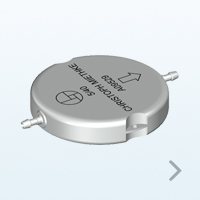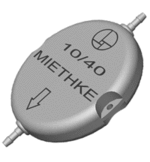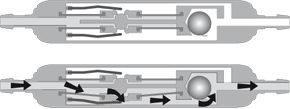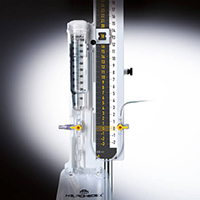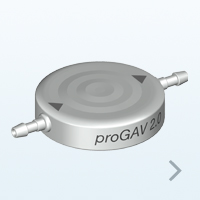Some patients treated with a shunt system face the risk of valve blockage due to the presence of blood in the cerebrospinal fluid (CSF). A high protein level or tumor cells in the CSF can also lead to valve blockage. These issues were given particular consideration in the development of the DUALSWITCH-VALVE. The robust titanium casing consists of two parallel chambers that present a very large surface area to the CSF. A large area also allows a higher force, which is provided by a relatively stiff spring, making the valve mechanism effectively immune against any of the problems associated with proteins, blood or tumor cells.
Description
DSV ®
Some patients treated with a shunt system face the risk of valve blockage due to the presence of blood in the cerebrospinal fluid (CSF). A high protein level or tumor cells in the CSF can also lead to valve blockage. These issues were given particular consideration in the development of the DUALSWITCH-VALVE. The robust titanium casing consists of two parallel chambers that present a very large surface area to the CSF. A large area also allows a higher force, which is provided by a relatively stiff spring, making the valve mechanism effectively immune against any of the problems associated with proteins, blood or tumor cells.
The DUALSWITCH-VALVE allows control of the intraventricular pressure regardless of CSF composition/ production, the subcutaneous pressure and the patient’s posture.
Function
The DUALSWITCH-VALVE consists of two parallel chambers, one for the patient’s supine and one for the patient’s upright position. This construction allows the valve to distinguish between the horizontal and vertical position of the patient. The robust titanium casing (grey) contains two titanium discs connected to the casing by two silicone membranes (yellow). Two bow springs (red) act on the discs and determine the opening pressure required for each chamber with their respective preload force. The tantalum ball (green) acts as a “switch” in case the patient gets up. In this way, overdrainage is prevented.
Horizontal Position
As long as the production and resorption of the CSF is balanced and the intraventricular pressure (IVP) is in the normal range, the DUALSWITCH-VALVE is closed. In the horizontal body position, any disturbance of this balance leads to an increasing IVP and causes the valve’s low pressure chamber to eventually open (chamber on the bottom). As a result, the drainage of CSF is possible and the intraventricular pressure returns to normal.
Vertical Position
If the patient moves to the upright body position, the low pressure chamber of the DUALSWITCH-VALVE is closed by the tantalum ball. Hence, only by way of the high pressure chamber is CSF-drainage possible. The opening pressure in the high pressure chamber is higher than the opening pressure in the low pressure chamber. By this mechanism the DUALSWITCH-VALVE prevents overdrainage in vertical body position.
Downloads
Additional information
| Brand | The Christoph Miethke GmbH & Co. KG |
|---|

